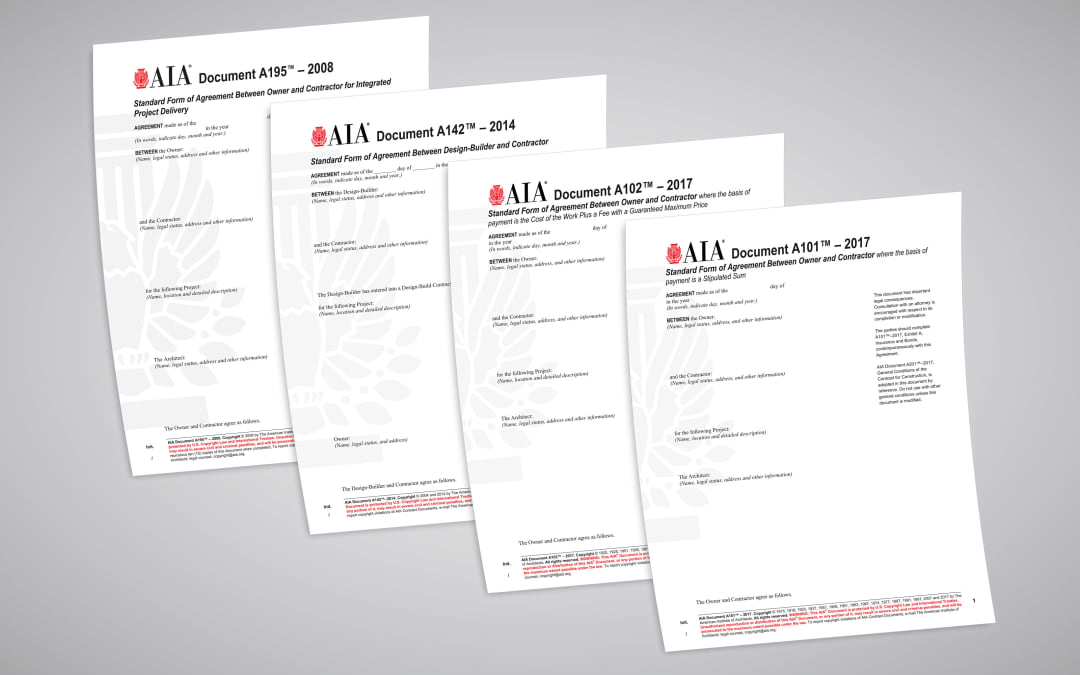Access the A101-2017, A102–2017™, A142–2014 and A195–2008
To purchase a one-time use license for the documents in this article, visit the links below:
A101-2017 Fixed-price Contract Between Owner and Contractor for a Commercial Construction Project
A102-2017, Standard Form of Agreement Between Owner and Contractor
A142– 2014 Design-Builder-Contractor
A195- 2008 Owner-Contractor Agreement for Integrated Project Delivery
Interested in getting unlimited access to our full 250+ library of agreements and forms? Visit the link below to learn more:
https://shop.aiacontracts.com/unlimited-subscription
May 5, 2023
A construction contract is an agreement between two or more parties to perform construction on a project according to certain terms and conditions. These contracts are comprised of general and special conditions. They address topics such as scope of work, payments, schedule, and quality to address each party’s rights and obligations. There are many types of construction contracts available in the industry, but here are four types with which all professionals should be familiar.
Stipulated Sum Contract
A stipulated sum contract, also called a lump sum or fixed price contract, is the most basic form of agreement between a contractor and owner. This contract should be used if the scope and schedule of the project are appropriately defined to allow the contractor to fully estimate project costs.
A stipulated sum contract requires that the contractor agree to be responsible for the proper job execution at a set price. The owner has essentially assigned the risk of project costs to the contractor, who can be expected to ask for a higher markup to anticipate unforeseen problems.
If the actual costs of labor and materials are higher than estimated, the contractor’s profit will be reduced. If the actual costs are lower, the contractor’s profit increases. Either way, the cost to the owner is the same. One example of a stipulated sum contract is AIA Contract Document A101-2017 Fixed-price Contract Between Owner and Contractor for a Commercial Construction Project.
Cost Plus Contract
Cost plus contracts are often used when the scope has not been clearly defined, such as when the project design is still being finalized and the owner wants to begin construction. An owner agrees to pay the cost of the work, including all trade subcontractor work, labor, materials, and equipment, plus an amount for contractor’s overhead and profit. Since the contractor is reimbursed only for actual costs, plus a fee for overhead and profit, if actual costs are lower than estimated, the owner gets to keep the savings. If the actual costs are higher than estimated, the owner must pay the additional amount, unless the cost is capped at a guaranteed maximum price. The advantage of a cost plus contract is that the project will result in what was intended, even if costs run high. However, despite the lower amount of risk for the contractor, these contracts are harder to track and more supervision is needed. The most common cost plus contracts are:
- Cost Plus Fixed Percentage – Contractor compensation for overhead and profit is based on a percentage of the actual cost.
- Cost Plus Fixed Fee – Contractor compensation is based on a fixed sum independent of the final project cost. The customer agrees to reimburse the contractor’s actual costs, regardless of amount, and in addition pay a negotiated fee independent of the amount of the actual costs.
- Cost Plus Fixed Fee with Guaranteed Maximum Price Contract – Compensation is based on a fixed sum of money. The total project cost to the owner will not exceed an agreed upper limit. One example of a Cost Plus Fixed Fee with Guaranteed Maximum Price Contract is AIA Contract Document A102-2017, Standard Form of Agreement Between Owner and Contractor where the basis of payment is the Cost of the Work Plus a Fee with a Guaranteed Maximum Price.

Common construction contracts
Design-Build Contract
A design-build contract is appropriate when the owner wants one entity to be responsible for both design and construction. Design-build is usually the preferred contracting method under a tight schedule, and design-build contracts are often awarded through negotiation rather than through a bid process.
With a design-build contract, the owner hires a design-builder (typically a contractor) to handle the entirety of a project. The design-builder is responsible for all design and construction required to complete the project. Since the design-build entity is head of the whole project, it may need to hire architects, engineers, contractors, or subcontractors to carry out the project. One example of a design-build contract is A142– 2014 Design-Builder-Contractor .
Integrated Project Delivery Contract
Integrated Project Delivery (IPD) contracts are a project delivery approach that integrate people, systems, business structures, and practices into a process that collaboratively harnesses the talents and insights of all participants to optimize project results, increase value to the owner, reduce waste, and maximize efficiency through all phases of design, fabrication, and construction.
IPD principles can be applied to a variety of contractual arrangements, and IPD teams can include members well beyond the basic triad of owner, architect, and contractor. This contract type results in more transparency among all the parties involved on a construction project. Additionally, both risk and reward are shared by the parties who enter into this contract. One example of an Integrated Project Delivery contract is A195- 2008 Owner-Contractor Agreement for Integrated Project Delivery.
These major contract types can have many variations and can be customized to meet specific needs of the product or the project. By using AIA Contract Documents, owners, contractors, architects, consultants, and attorneys can choose and customize over 180+ industry standard construction contracts and forms.
For more information and samples of construction contracts, visit AIA Contract Documents (aiacontracts.com).
Caitlin Sweeney is Marketing Operations Manager at AIA Contract Documents.
AIA Contract Documents has provided this article for general informational purposes only. The information provided is not legal opinion or legal advice and does not create an attorney-client relationship of any kind. This article is also not intended to provide guidance as to how project parties should interpret their specific contracts or resolve contract disputes, as those decisions will need to be made in consultation with legal counsel, insurance counsel, and other professionals, and based upon a multitude of factors.

